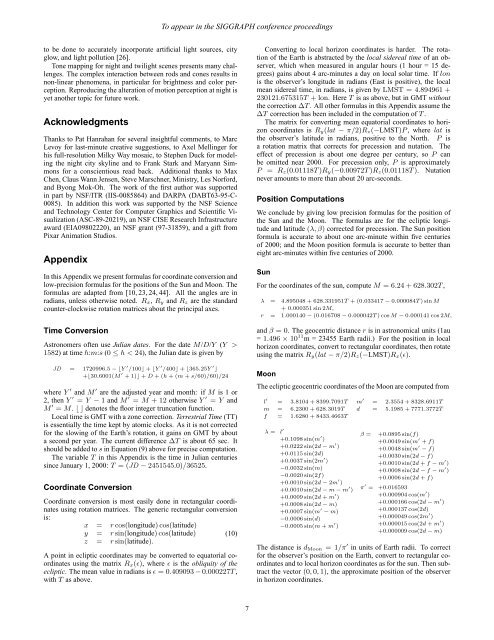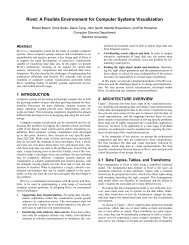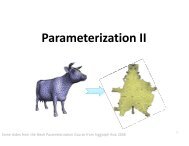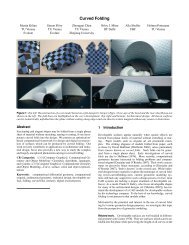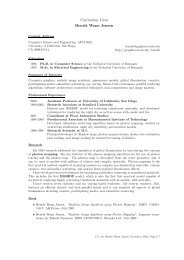A Physically-Based Night Sky Model - Computer Graphics Laboratory
A Physically-Based Night Sky Model - Computer Graphics Laboratory
A Physically-Based Night Sky Model - Computer Graphics Laboratory
You also want an ePaper? Increase the reach of your titles
YUMPU automatically turns print PDFs into web optimized ePapers that Google loves.
to be done to accurately incorporate artificial light sources, city<br />
glow, and light pollution [26].<br />
Tone mapping for night and twilight scenes presents many challenges.<br />
The complex interaction between rods and cones results in<br />
non-linear phenomena, in particular for brightness and color perception.<br />
Reproducing the alteration of motion perception at night is<br />
yet another topic for future work.<br />
Acknowledgments<br />
Thanks to Pat Hanrahan for several insightful comments, to Marc<br />
Levoy for last-minute creative suggestions, to Axel Mellinger for<br />
his full-resolution Milky Way mosaic, to Stephen Duck for modeling<br />
the night city skyline and to Frank Stark and Maryann Simmons<br />
for a conscientious read back. Additional thanks to Max<br />
Chen, Claus Wann Jensen, Steve Marschner, Ministry, Les Norford,<br />
and Byong Mok-Oh. The work of the first author was supported<br />
in part by NSF/ITR (IIS-0085864) and DARPA (DABT63-95-C-<br />
0085). In addition this work was supported by the NSF Science<br />
and Technology Center for <strong>Computer</strong> <strong>Graphics</strong> and Scientific Visualization<br />
(ASC-89-20219), an NSF CISE Research Infrastructure<br />
award (EIA09802220), an NSF grant (97-31859), and a gift from<br />
Pixar Animation Studios.<br />
Appendix<br />
In this Appendix we present formulas for coordinate conversion and<br />
low-precision formulas for the positions of the Sun and Moon. The<br />
formulas are adapted from [10, 23, 24, 44]. All the angles are in<br />
radians, unless otherwise noted. Rx, Ry and Rz are the standard<br />
counter-clockwise rotation matrices about the principal axes.<br />
Time Conversion<br />
Astronomers often use Julian dates. For the date M/D/Y (Y ><br />
1582) at time h:m:s (0 ≤ h < 24), the Julian date is given by<br />
JD = 1720996.5 − ⌊Y ′ /100⌋ + ⌊Y ′ /400⌋ + ⌊365.25Y ′ ⌋<br />
+⌊30.6001(M ′ + 1)⌋ + D + (h + (m + s/60)/60)/24<br />
where Y ′ and M ′ are the adjusted year and month: if M is 1 or<br />
2, then Y ′ = Y − 1 and M ′ = M + 12 otherwise Y ′ = Y and<br />
M ′ = M. ⌊ ⌋ denotes the floor integer truncation function.<br />
Local time is GMT with a zone correction. Terrestrial Time (TT)<br />
is essentially the time kept by atomic clocks. As it is not corrected<br />
for the slowing of the Earth’s rotation, it gains on GMT by about<br />
a second per year. The current difference ∆T is about 65 sec. It<br />
should be added to s in Equation (9) above for precise computation.<br />
The variable T in this Appendix is the time in Julian centuries<br />
since January 1, 2000: T = (JD − 2451545.0)/36525.<br />
Coordinate Conversion<br />
Coordinate conversion is most easily done in rectangular coordinates<br />
using rotation matrices. The generic rectangular conversion<br />
is:<br />
x = r cos(longitude) cos(latitude)<br />
y = r sin(longitude) cos(latitude) (10)<br />
z = r sin(latitude).<br />
A point in ecliptic coordinates may be converted to equatorial coordinates<br />
using the matrix Rx(ɛ), where ɛ is the obliquity of the<br />
ecliptic. The mean value in radians is ɛ = 0.409093 − 0.000227T ,<br />
with T as above.<br />
To appear in the SIGGRAPH conference proceedings<br />
7<br />
Converting to local horizon coordinates is harder. The rotation<br />
of the Earth is abstracted by the local sidereal time of an observer,<br />
which when measured in angular hours (1 hour = 15 degrees)<br />
gains about 4 arc-minutes a day on local solar time. If lon<br />
is the observer’s longitude in radians (East is positive), the local<br />
mean sidereal time, in radians, is given by LMST = 4.894961 +<br />
230121.675315T + lon. Here T is as above, but in GMT without<br />
the correction ∆T . All other formulas in this Appendix assume the<br />
∆T correction has been included in the computation of T .<br />
The matrix for converting mean equatorial coordinates to horizon<br />
coordinates is Ry(lat − π/2)Rz(−LMST)P , where lat is<br />
the observer’s latitude in radians, positive to the North. P is<br />
a rotation matrix that corrects for precession and nutation. The<br />
effect of precession is about one degree per century, so P can<br />
be omitted near 2000. For precession only, P is approximately<br />
P = Rz(0.01118T )Ry(−0.00972T )Rz(0.01118T ). Nutation<br />
never amounts to more than about 20 arc-seconds.<br />
Position Computations<br />
We conclude by giving low precision formulas for the position of<br />
the Sun and the Moon. The formulas are for the ecliptic longitude<br />
and latitude (λ, β) corrected for precession. The Sun position<br />
formula is accurate to about one arc-minute within five centuries<br />
of 2000; and the Moon position formula is accurate to better than<br />
eight arc-minutes within five centuries of 2000.<br />
Sun<br />
For the coordinates of the sun, compute M = 6.24 + 628.302T ,<br />
λ = 4.895048 + 628.331951T + (0.033417 − 0.000084T ) sin M<br />
+ 0.000351 sin 2M,<br />
r = 1.000140 − (0.016708 − 0.000042T ) cos M − 0.000141 cos 2M,<br />
and β = 0. The geocentric distance r is in astronomical units (1au<br />
= 1.496 × 10 11 m = 23455 Earth radii.) For the position in local<br />
horizon coordinates, convert to rectangular coordinates, then rotate<br />
using the matrix Ry(lat − π/2)Rz(−LMST)Rx(ɛ).<br />
Moon<br />
The ecliptic geocentric coordinates of the Moon are computed from<br />
l ′<br />
= 3.8104 + 8399.7091T m ′ = 2.3554 + 8328.6911T<br />
m = 6.2300 + 628.3019T d = 5.1985 + 7771.3772T<br />
f = 1.6280 + 8433.4663T<br />
λ = l ′<br />
+0.1098 sin(m ′ )<br />
+0.0222 sin(2d − m ′ )<br />
+0.0115 sin(2d)<br />
+0.0037 sin(2m ′ )<br />
−0.0032 sin(m)<br />
−0.0020 sin(2f)<br />
+0.0010 sin(2d − 2m ′ )<br />
+0.0010 sin(2d − m − m ′ )<br />
+0.0009 sin(2d + m ′ )<br />
+0.0008 sin(2d − m)<br />
+0.0007 sin(m ′ − m)<br />
−0.0006 sin(d)<br />
−0.0005 sin(m + m ′ )<br />
β = +0.0895 sin(f)<br />
+0.0049 sin(m ′ + f)<br />
+0.0048 sin(m ′ − f)<br />
+0.0030 sin(2d − f)<br />
+0.0010 sin(2d + f − m ′ )<br />
+0.0008 sin(2d − f − m ′ )<br />
+0.0006 sin(2d + f)<br />
π ′ = +0.016593<br />
+0.000904 cos(m ′ )<br />
+0.000166 cos(2d − m ′ )<br />
+0.000137 cos(2d)<br />
+0.000049 cos(2m ′ )<br />
+0.000015 cos(2d + m ′ )<br />
+0.000009 cos(2d − m)<br />
The distance is dMoon = 1/π ′ in units of Earth radii. To correct<br />
for the observer’s position on the Earth, convert to rectangular coordinates<br />
and to local horizon coordinates as for the sun. Then subtract<br />
the vector (0, 0, 1), the approximate position of the observer<br />
in horizon coordinates.


